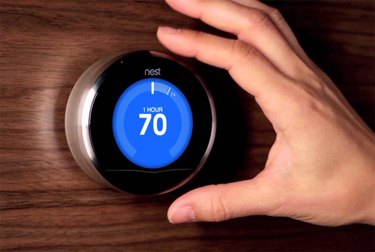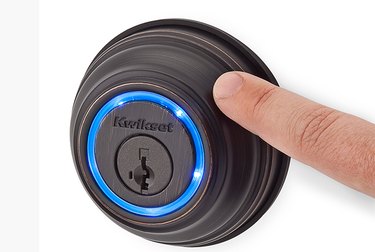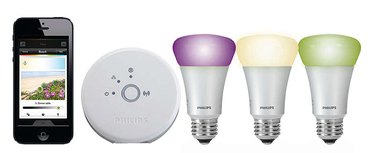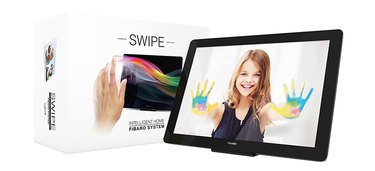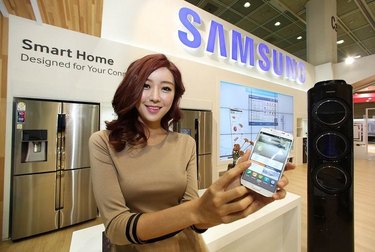
Picture the scene: You return home and the door automatically unlocks. You enter and soft mood lighting comes on. Your favorite mellow house mix starts to play. The temperature rises to a comfortable 74°F. You plop down on the sofa, uncork a Chianti, and absentmindedly gesture at the shades, which rise at your command.
The above scenario illustrates the promise of smart homes. It's called a "scene"—a series of prearranged actions triggered by your presence (or more precisely, by the presence of your smartphone, which you've parked in your pocket or your purse). What happened? The door's deadbolt retracted, the lights came on, the music played, and the thermostat went into action—just as you preprogrammed them to do. The robot to pour your Chianti, alas, has not yet been perfected. But many of the technological gadgets that make for such a comforting return home are in the here and now. Let's take a look at them.
Video of the Day
Video of the Day
Smart Thermostats
Thermostats were one of the first devices to get smart. The credit goes partly to Tony Fadell, "one of the fathers of the iPod," who went searching for thermostats for an energy-efficient home he was building near Lake Tahoe and was disappointed in the options available. Determined to build a better thermostat, Fadell founded Nest Labs in 2010. The resulting Nest Learning Thermostat still leads its category.
What does Nest do? For starters, it learns your temperature preferences by identifying patterns of usage. All you do is set the temperature where you want it throughout the day, and soon enough Nest catches on and starts doing it for you. Nest will turn itself down when you leave—the key to energy savings—and turn itself back up when you come home. Nest thermostats have started to integrate with smart locks and security systems, too, making them part of a larger smart home ecosystem. Nest's third-generation product includes new features such as a 40 percent larger screen and Farsight, which spots you across the room and lights up so you can read the temperature. The latest Nest also provides a way to monitor your furnace. The Nest Learning Thermostat retails for $249.
The Ecobee3 Wi-Fi Smart Thermostat is from Toronto-based Ecobee, which was actually the first company to produce an app-enabled thermostat. It's less well-known than Nest because it required professional installation.
To compete with Nest and other install-it-yourself rivals, the firm released the Ecobee3, which comes with a 3.5-inch LCD touchscreen, knows when to turn on your heating and cooling system to keep things comfortable, and can detect when someone is home and which room is occupied. Like Nest, the Ecobee3 lets you control and monitor your home's temperature from anywhere. Two things distinguish it from the Nest: It's compatible with HomeKit, Apple's smart home network, and it includes a remote sensor for monitoring an individual room and maintaining a different temperature there than in the rest of the house. (You can purchase additional remote sensors separately.) The Ecobee3 thermostat retails for $249.
The Honeywell Wi-Fi Smart Thermostat offers many of the same features as Nest and Ecobee.
The decision about which one to choose might come down to the type of display you prefer. Honeywell's smart thermostat sports a large, customizable LCD touchscreen that offers all kinds of information, including indoor and outdoor temperature and humidity readings. Honeywell also introduced a voice control version a few years back that enables you to control the thermostat with simple voice commands, like "Make it four degrees warmer." The voice version retails for $300. The thermostat without voice control retails for $230.
Smart Security Cameras
The Piper NV from Icontrol Networks is an elegantly designed camera that keeps tabs on the goings on in your home while you're away. The NV stands for "night vision": Infrared sensors around its lens give this camera the power to see in the dark. The device sports a 3.4-megapixel full-HD camera that can pan and tilt, providing a 180° field of view, which the company says is the widest available on the market.
The Piper NV also boasts a 105-decibel siren that will assault the eardrums of any would-be burglar, and a microphone for two-way audio so you can tell the burglar in your best Darth Vader voice, "I have you now," as he trips over the coffee table in his haste to flee the siren. The Piper NV supports Android and iOS devices. It gets high marks for ease of setup and ease of use. The camera retails for $279.
Vivint's Ping is a security camera with a twist. Most indoor monitoring cameras allow you to call in. This is the first one that lets you call out, thanks to a button at the top for one-touch calling. Remote users get a notification on their smartphone and can talk to the person on the other end. Think FaceTime. It's an unusual feature and came about through real-world experience. Matt Eyring, chief strategy and innovation officer at Vivint, explains, "Our research showed that younger children, specifically those without cell phones, were ringing our doorbell camera to talk to their parents. With Vivint Ping, we've created an indoor camera that makes these quick check-ins simple." The Vivint Ping will be available in the second quarter of 2016 as part of Vivint's Smart Home product suite.
An outdoor security camera that garnered a lot of attention (and four Innovation Awards) at this year's Consumer Electronics Show in Las Vegas is Netatmo's Presence. It knows what it sees, as spooky as that sounds, thanks to a deep learning algorithm that helps it identify cars, people, and animals. The camera sends notifications to the user that identify what it viewed, with notes like "Car Seen," "Person Seen," or "Animal Seen." The camera also has night vision and records bright color videos even in the dark. Its smart floodlight can be set to scare off unwanted visitors. The Presence will be available in the third quarter of 2016. Pricing hasn't been set.
Smart Locks
Along with smart cameras, smart locks are making inroads in the home security market. Major manufacturers like Kwikset, Schlage, and Master Lock have introduced products in this category. Kwikset introduced the first Bluetooth-enabled smart lock, Kevo, in 2013.
You simply touch the lock, and—as long as your smartphone is nearby—the deadbolt opens. If you don't have your smartphone with you, a supplied key fob will do. You can also give temporary eKeys to people who need access, like handymen and dog walkers. Kevo integrates with a host of smart devices, including Nest and Honeywell thermostats. Kevo retails for $199.
Apple fans will want to take a close look the Schlage Sense Smart Deadbolt. Because it's compatible with HomeKit, Apple's smart home network, you can unlock your door using Siri voice control on your iPhone.
Schlage recently announced an app for the Apple watch as well. Alternatively, you can open the lock via a touchscreen. Like the Kevo, the Sense Smart Deadbolt permits you to create temporary codes for workers or guests who need access to your home. The Schlage Sense Smart Deadbolt retails for $229.
The August Smart Lock installs easily onto your existing deadbolt and works with both Android and iOS devices, including the Apple Watch. It locks automatically when you leave and unlocks as you approach, using your smartphone as the key.
The associated smartphone app maintains a 24/7 activity log so you can see who has come and gone during your absence. The August Smart Lock retails for $199.
The Ring Video Doorbell <ahref="https: techwalla.com="" products="" ring-video-doorbell-smart-home"=""> </ahref="https:>isn't exactly a lock, but it makes a great addition to your security setup. A popular seller, it connects to your Wi-Fi, letting you answer the door from anywhere by using your smartphone. With its built-in HD camera, you can see who's at the door.
Ring's booth at CES featured a video compilation showing how its video doorbell stopped potential burglars. They would come to the door and bang loudly to see if anyone was home. The Ring's motion sensor would then alert the homeowner, and—despite not being at home—the homeowner would surprise the burglar via speakerphone. At that point the would-be burglar always beat a hasty retreat. The Ring Video doorbell has a night-vision capability and retails for $199.
Smart Lights
One of the most impressive aspects of smart home tech is what it has done for lights. Not only can smart lights be adjusted to produce millions of colors, but they can turn on to welcome you home and turn off as you leave. You can sync them with music, have them dim as you go to sleep, and have them dial up in strength to wake you up. An early innovator in this area (and still a major player) is Philips, with its Hue line of products, which now work with Apple HomeKit. Philips offers starter kits at prices ranging from $79 to $199.
Another company doing cool things with lights is Sengled, which specializes in combining light bulbs and speakers. Sengled's Pulse Starter Kit includes two bulbs and transforms your light system into a speaker system. You can connect up to seven bulbs to the system and stream music throughout your house. The two-bulb starter kit retails for $150.
Sengled is also at work developing new and elegant designs, like the Pulse Onion and Pulse Horn, and the company has begun combining things other than speakers with its bulbs. For example, its Snap bulb combines a light and an HD camera. Sengled recommends putting the Snap over entryways and garages to keep an eye on things.
It's a good idea to disguise a camera, since tech-savvy robbers sometimes take out ordinary cameras. We've all seen video footage of masked thieves spray painting over security cameras, but bad guys are unlikely to take notice of a light bulb. The Snap retails for $150.
The light bulbs available from BeON Home deserve special mention here for their standout security features. These bulbs learn your lighting patterns. Then, when you're away, they mimic your behavior to make it appear that you're at home and behaving as usual.
The lights also learn the sound of your doorbell. If you're out and the doorbell rings, the lights will act as if you are moving about the house, lighting first the upstairs bedroom, then the stairway, and then the hall. If that doesn't convince a sneak-thief to skedaddle, we don't know what will. BeON light bulbs also hold a 4-hour battery charge in case the house's power goes out, and they turn on if the smoke alarm goes off. As Tech Times says: "If a lightbulb could be a kind of superhero, this one would be the closest thing to it." The company sells its three-light-bulb kit for $199.
Smart Home Controllers
Smartphone apps may look like the be-all and end-all of smart home control, but other options are coming to market as well. One of the coolest we've seen is the Swipe Wireless Gesture Control Pad from Fibaro.
This 5-by-7-inch tablet-size device recognizes six gestures—up, down, left, right, circle to the left, and circle to the right. Swipe definitely gives you a Jedi-like feeling as you wave your hand to close shades, control lights, and flip through song lists. And Swipe's connectivity is strong enough that you can put it behind drywall or under a counter. But be warned: Hiding it will only increase the deceptive feeling that the Force is with you, which may lead to problems as you leave your smart home for the real world, where the Force doesn't actually exist. Swipe will retail for $150.
Voice control is becoming another popular way to control smart home devices and gadgets. For HomeKit-enabled smart devices, there's Siri. For others, there's Alexa, the voice of the Amazon Echo, which is emerging as an alternative voice controller for non-HomeKit products.
The voice-activated 9-inch tower started life as a streaming music speaker that offered an occasional weather report, but it's turning into much more than that as smart gadgets achieve mainstream acceptance. Smart home companies like Vivint, Insteon, Nexia, and Elgato are incorporating Echo into their offerings. Amazon's Echo retails for $180.
If remotes are more your thing, you have options there, too. Savant Systems, well-established as a developer of high-end home automation systems for the luxury market—think castles, estates, and super yachts—recently announced its new Savant Remote.
Its look and feel are in keeping with Savant's luxury pedigree. The $500 device can control all your home entertainment systems and even your lights. So you can set your living room for movie night at the touch of a button. Another option is Logitech's Harmony Elite.
Like the Savant Remote, it controls all of your home entertainment systems, and it's compatible with various smart home devices, including Philips Hue lights, August Smart Locks, and Nest thermostats. The Logitech Harmony Elite retails for $350.
Conclusion
For smart home products, the future looks bright. It's the kind of technology that will change how we live our lives. Today, smart homes are still in their infancy. It's an exciting period of early adopters, multiple standards, and new and interesting designs, but also one hampered by a lack of real-world experience. Nevertheless, the time is fast approaching when every home will be a smart home.
